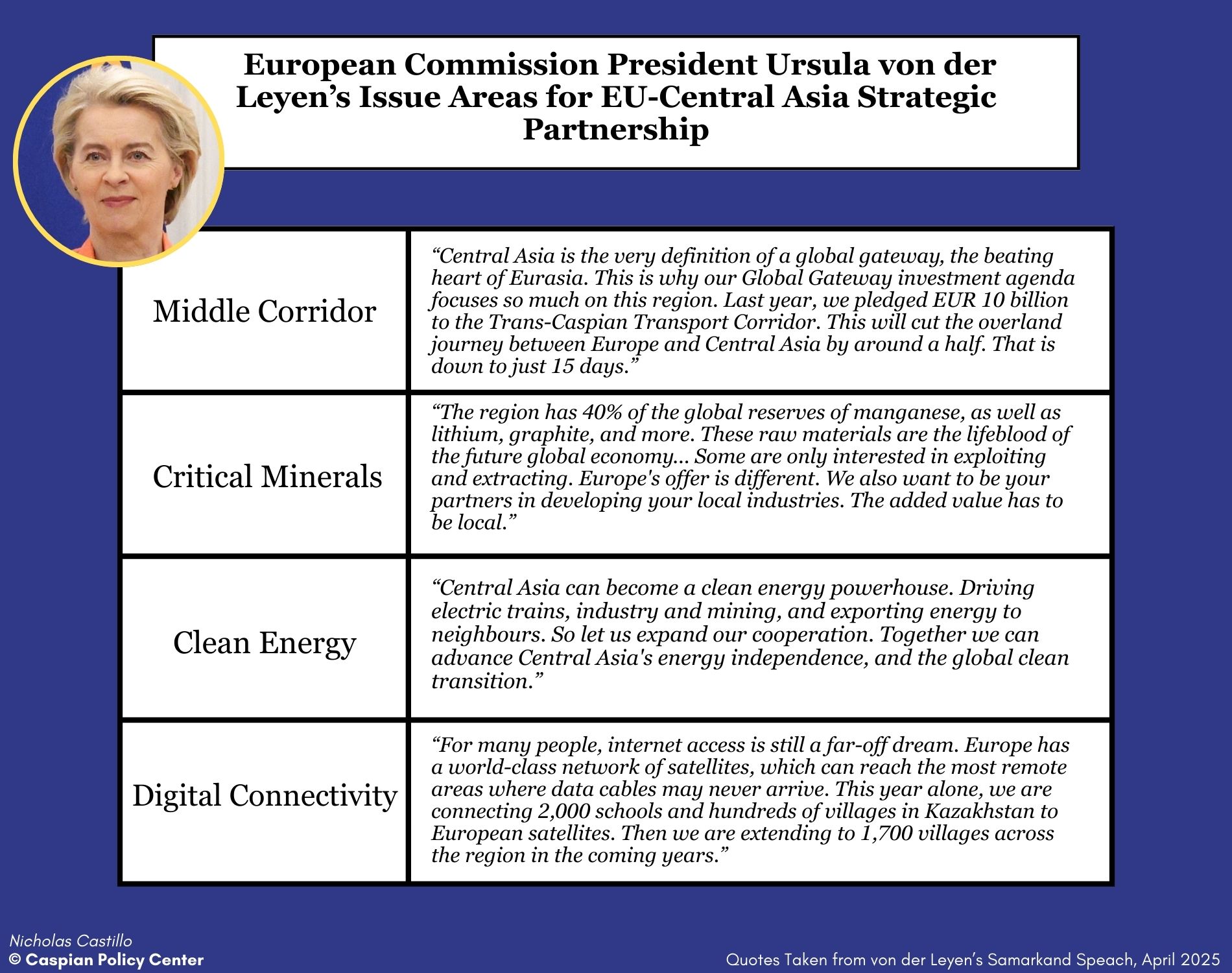Strengthening Ties: EU-Central Asia Summit Paves the Way for a Robust Strategic Partnership
Recent Articles
Author: Nicholas Castillo
04/04/2025
The European Union’s landmark Samarkand summit appears to have heralded a new era of relations between Central Asia and the EU. The summit brought the EU’s top leadership, European Commission President Ursula von der Leyen and President of the European Council António Costa, together with the five Central Asian Presidents, providing a forum for the EU to lay out its vision for a new strategic partnership between the two regions.
Von der Leyen’s speech outlined four areas of EU-Central Asia cooperation: the Middle Corridor, critical minerals, clean energy, and widespread internet access across Central Asia. The EU Commission president emphasized that, with the recent billions of euros in investments in Central Asian connectivity, the EU was seeking to cut commercial goods transit times to Europe to 15 days. For critical minerals, von der Leyen underscored the value the EU is hoping to provide locally by way of mass investments, saying, “Together, we could build local industries right along the raw-materials value chain. From mining to refining, from opening new research labs to training local workers, we want to build a long-term partnership.”
In her summation, von der Leyen announced a 12-billion-euro commitment to the region through the EU’s Global Gateway program – although it remains to be seen how much of this is totally new funding as opposed to re-packaged investments already allocated to the region. She additionally announced that a new Central Asia Investors Forum would be held in Uzbekistan in 2025.

António Costa, President of the European Council, was also in attendance and echoed many of von der Leyen’s sentiments, saying, “It is time to take our partnership with Central Asia to the next level, deepening trade, strengthening regional collaboration, and expanding people-to-people ties.”
The ongoing efforts at peace and normalization between Armenia and Azerbaijan were also referenced twice by von der Leyen. She described conflict resolution as a major potential boost to regional east-west connectivity. Furthermore, the summit’s joint declaration referred to peace in the South Caucasus as a “prerequisite to the successful implementation” of other projects in Central Asia. She strongly implied that this proviso places a potential veto on existing funds, should the conflict not be resolved in the near future.
As for the Central Asian leaders, they welcomed the EU’s interest and commitment to strengthening ties. During his official remarks, Uzbekistan President Shavkat Mirziyoyev, the host of the summit, thanked the EU and stated that the “demand for close cooperation” between Europe and Central Asia is “only growing.” Mirziyoyev additionally proposed greater EU-Central Asia inter-parliamentary cooperation and , among other proposals, backed calls for the EU summit to occur on a bi-annual basis. Kazakhstan President Kassym-Jomart Tokayev likewise commended the growth in EU-Central Asian relations, expressing interest in further expanding trade and energy security ties.
The summit in Samarkand has come amid the turmoil brought on by new tariffs that U.S. President Trump announced just prior to the Summit: a 27% tariff applied to Kazakhstan and 10% applied to each of the four other Central Asian countries could become a deterrence to trade between the region and the United States. In this context, the EU appears to be promoting itself as a safe alternative and stable source of investment and partnership.
EU officials in Samarkand referenced themselves as “reliable” and warned of greater geo-political tensions and the rise of new spheres of influence. Several of the initiatives outlined as part of the EU-Central Asia strategic partnership are items the United States had previously expressed interest in, such as critical mineral supplies. Speeches by both European and Central Asian officials made several references to global tensions and shifting politics requiring dependable partnerships.
European interest in Central Asia is by no means a new phenomenon. For years, the EU has been investing in Central Asian connectivity, resources, and markets. Yet, in recent months, Brussels’ attention toward the region has taken on a broader and more political tone. Kaja Kallas, the EU’s top diplomat and perhaps the EU’s best known anti-Russia hawk, visited Central Asia shortly before von der Leyen. Speeches in Samarkand underscored not only the EU’s economic interest in the region, but also highlighted the fast-moving geopolitical landscape and Europe’s commitment to Central Asia’s sovereignty.